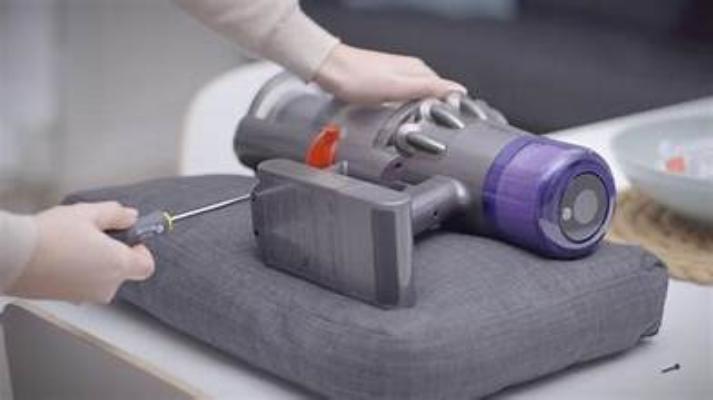Even this well-known cleaning appliance needs to be cleaned occasionally. Dyson vacuums are designed to gather and retain tiny particles, assisting in the removal of dust, dirt, and dander from your home.
One of our favorite cordless stick vacuums available is the Dyson, which has multiple dust- and dirt-filled chambers. The vacuum’s performance is decreased due to tiny particles being stuck in it and dirtying the filter and vacuum. Here are some easy cleaning suggestions for your Dyson vacuum so that it stays in perfect condition.
Items You’ll Require:

- Tools and Equipment
- 1 microfiber cloth
- One screwdriver with a Phillips head
- One small pair of scissors
- 1 Old toothbrush Supplies
- One bottle of dishwashing liquid and one warm water
Step By Step Guide:
How To Disassemble And Unplug A Dyson Vacuum Cleaner:

Unplug the vacuum to avoid shock accidents. Take out and empty the dust canister before giving it a wash in warm, soapy water. Dry with a microfiber towel after thorough rinsing.
After removing the filter or filters, proceed as directed in detail below.
Empty The Beater Bar:
The bristly beater bar may get matted with hair and threads, as well as stuck in dirt. The bottom cover plate may need to be removed with a Phillips head screwdriver, depending on the model of Dyson you have. Then gradually trim away tangles with a pair of tiny scissors.
Lastly, wipe the beater bar bristles with an old toothbrush or tiny brush to get rid of any dust buildup.
Examine The Hoses For Obstructions:
Eliminate the vacuum cleaner’s hose. To remove any stuck debris, hold the hose under a warm running faucet. You can hang the hose over a shower rod or any other well-draining place. Wait 24 hours or until the hose is dry before reattaching.
Clear The External Housing:
To make a microfiber cloth stop dripping, dip it in warm, soapy water and wring it out. Dust and filth can be removed by wiping down the exterior housing. Let it air dry.
How To Maintain A Vacuum Filter Dyson?
Take Off The Dyson Vacuum Filter:

While every Dyson vacuum is a little bit different, most filters can be taken out by twisting the filter’s end and drawing it out after pressing a release button.
Check your user manual or go to the Dyson website if you are having trouble removing the filter from your particular machine.
Take Out All Of The Dust From The Filter:

To get rid of any loose dust and particles, hold the filter over a sink or garbage can and give it a little shake. To remove particles, tap the filter on the side of the sink or trash can.
Only Use Water To Rinse The Filter:
After removing any remaining dust, give the filter a quick rinse with cold water (tap water will do). To make sure it gets thoroughly clean, give it a gentle hand massage.
The filter should not be cleaned with soap or detergent as this could corrode or harm the system.
Shake After Adding Warm Water To The Filter:
After washing, pour warm tap water into the filter. To get rid of any last bits of dirt, cover the holes on both ends of the filter and give it a good shake.
- Shake the filter vigorously to remove any remaining water once the water runs clear.
- Give the filter at least 24 hours to dry.
- After washing your filter, put it in front of a fan, an open window, or any other location where there is a lot of airflow. Give it at least 24 hours to air dry.
- Before reinstalling your filter in your Dyson vacuum, make sure it is fully dry because any moisture could harm the engine. If your filter is sufficiently dry to be reinserted into your machine, all it takes is a quick touch test.
Always Remember:
Never use a hair dryer, tumble dryer, microwave, open flame, or any other heating source to dry your Dyson filter. The best air is at room temperature.
How Often Is My Dyson Vacuum Clean?
As stated on the Dyson website, to maintain optimal performance, you should clean the filter and vacuum at least once a month. Depending on how frequently you use your vacuum cleaner and how big of messes you make, everyone has a different vacuum maintenance routine.
It might be time to clean your vacuum if you start to notice that it is not operating as well, that the suction has been exhausted, or that it is requiring more work on your part to finish the task of vacuuming.
Long-Term Care Advice For Your Dyson Vacuum:
Try to avoid using high-power mode as much as possible. Dyson vacuums are designed to operate regularly in auto or regular mode and at high power as necessary. Vacuuming on high power too frequently will overwork the device and raise the possibility of a clogged filter.
Before using a vacuum over the debris, gather and dispose of any larger pieces.
To reduce the work required for maintenance, clean the vacuum regularly.
FAQs:
How Is A Vacuum Cleaned?
Alright, stop worrying. The ideal method for giving your vacuum the boost it needs has been deconstructed by our cleaning specialists. There’s just one place to start when cleaning your vacuum: the filter. A regular and efficient cleaning schedule guarantees optimal suction and overall functionality.
How Do You Clean A Vacuum Filter?
Change the filter. A HEPA (High-Efficiency Particulate Air) filter on your vacuum will capture 99.97 percent of particulates that enter the device larger than.3 microns. HEPA filters, which are made of finely woven synthetic fibers, can frequently be cleaned by rinsing them in plain, cold water to remove dust.
Is It Possible To Use Water To Clean A Vacuum Cartridge Filter?
Please see your handbook for detailed cleaning instructions. In general, water works well if the cartridge filter is made of cotton. For paper filters, stay away from water.
Can Vacuum Filters Be Cleaned And Used Again?
The majority of vacuum filters are single-use. But simply clearing away the dust and dirt your filters collect, you can usually prolong their life.
Is It Possible To Use Soap And Water To Clean Foam Air Filters?
Water may be used to fully wash most foam filters. For foam, a light soap works well, but make sure to read the vacuum’s handbook for specific cleaning instructions.
Conclusion:
It’s easy to put off cleaning a vacuum’s internal components and hope for the best, but cleaning them isn’t always simple. The worst thing you can do, though, is nothing if the filters in your vacuum are clogged. The performance of your vacuum can be significantly hampered and even damaged by dust accumulation in the filters.

